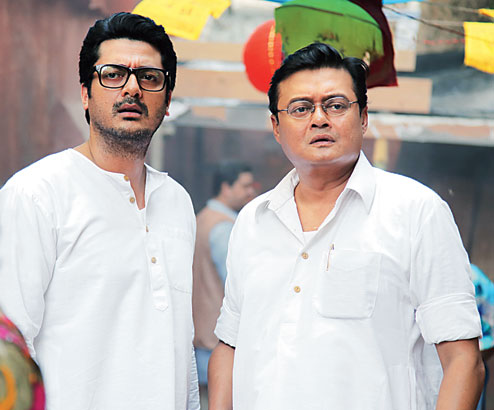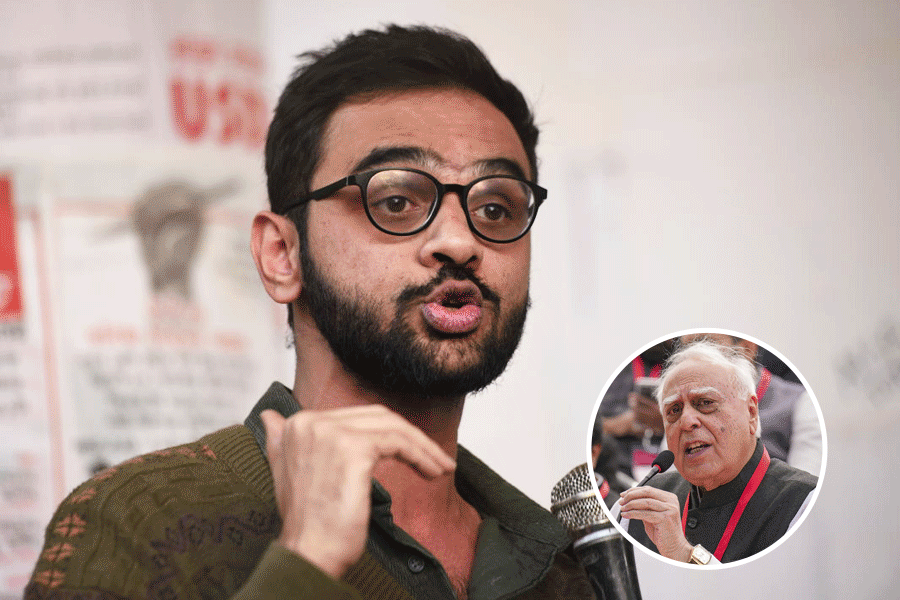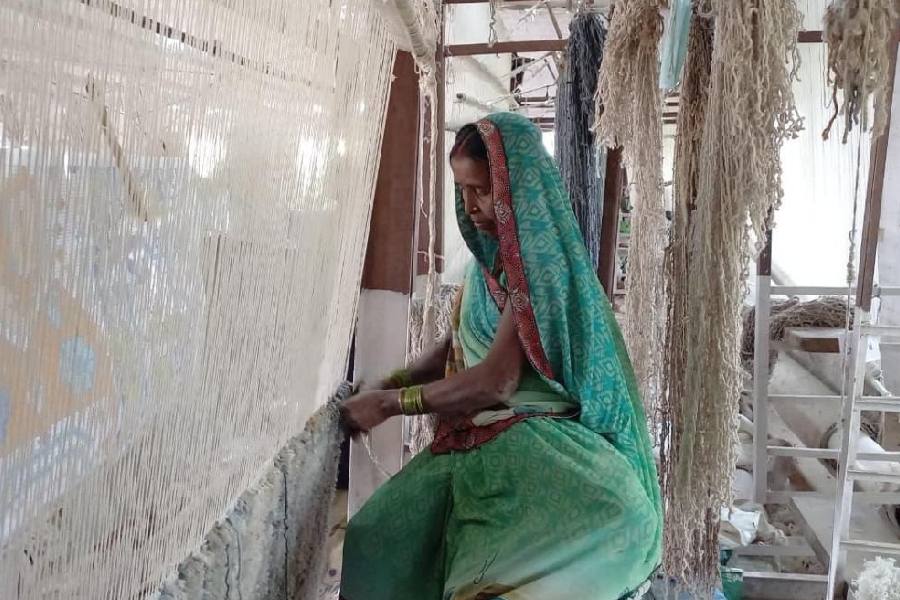
All good things need to change. Or else it gets boring, dusty, pallid. So, after five films, my Byomkesh Bakshi needed to be different.
Man on a mission
The change cannot be arbitrary. There are so many of you out there who have accepted my Byomkesh from Day One and did not care for the change in cast when Abir (Chatterjee) left. You were overwhelmed by a dhoti-clad, suave Jisshu Sengupta. I am and will forever be grateful to you. But if you look closely into Sharadindu’s (Bandyopadhyay) novels, you’ll find references of Byomkesh Bakshi frequently travelling to Delhi or Rangoon to take up dangerous government missions. Therefore, one can easily conclude that Bakshi can handle a gun if required. His world is dark, unpredictable and moody. His world is also political. With Agniban and Uposhonghar, he enters into an international conspiracy.
To achieve these, firstly my script had to be more layered. The cinematography had to incorporate the noir. And then the background score had to inevitably move towards jazz.
Coffee and vodka sessions
I was lucky to have worked as an actor in Shaheb Bibi Golaam where I met Gairik Sarkar, the cinematographer. I was convinced that Gairik would be able to deliver the exact look and feel. My music director Neel Dutt had sat with him extensively to rework the theme of Byomkesh, which by now is rather identifiable. The entire colour scheme was relooked into by Gairik, who decided on two primary colours for the two stories which are intercut. My editor, Arghyakamal Mitra, kept pushing us towards Hitchcock. Lots of coffee, vodka and cigarettes were consumed during our sessions. Finally, we ended up with a somewhat bigger budget.
Rocking the boat
Now, you may question very logically why this brainstorming? Why at all push the budget? Especially at a time when Bengali cinema is going through a financial gloom. My Byomkesh has been a low-budget hit every Puja. Why rock the boat and risk the formula?
See, many of us as suppliers or you as takers have started defining ‘commercial art’ in our personal, half-baked terms. We are stuck in our own little wells. We do not check out on the legacy or history of this art form. We live on random remarks and judgement. Our expectations are thereby limited. Our definition of what needs to change and how are foggy. Therefore the courage required in pushing the envelope becomes rare. Most of you as audience are simply happy with good stories. And most of us, with good storytelling.
But ask yourself: is cinema just about storytelling? Is it not about pleasure of the senses? The pleasure to the eye? To the ear? To the tension in our hearts or other places?

My second-last Byomkesh
To me, till date, my Byomkesh has been well-told stories, mounted decently. That’s it. It did not have the zing or sting that the iconic Byomkesh Bakshi deserves in cinema. I say this with a lot of love, respect and humility to all those who helped me make it a successful franchise since 2010. You and my unit.
But now that I am producing my second-last Byomkesh (I have the rights of just one more story, Durgo Rahoshya), I needed to give my Bakshi the look and feel he deserves. I am extremely grateful to my financiers, Kaustuv Roy, and Ashok and Himanshu Dhanuka of Eskay Movies, who gave me the funds required to upscale. Yet, I have continuously kept a check on how much should I change and not go overboard.
Time and place
Sharadindubabu had placed his Agniban and Uposhonghar in the late ’40s. I had already placed my first Byomkesh with Abir during the 1962 communal riots. Chitrachor was therefore set in 1964. Benisonghar was set in 1968 (where, through the character of Makarand, I had shown the Left party having inner party conflicts). Kohen Kobi Kalidas with Jisshu was set in 1968. Chiriakhana was set in 1971. Therefore this Byomkesh O Agniban is set in 1971, against the backdrop of Naxalite movement and the Vietnam war. Instead of the Japanese Imperialist connection of the original, it’s now the US connection. All things fall into place.
Why am I rambling on all these changes or interpolations?
Aesthetically close changes
Dear audience, it is extremely crucial for both of us to truly understand the implications of adaptations or so-called ‘modernisation’. Many of us very easily refer to Guy Ritchie’s Sherlock as modernised. True. The man did very successfully manage to give us a contemporary feel to the ‘old-fashioned’ Holmes. But did he put in modern cars instead of horse carriages? Did he dispense with the violin and give Holmes a guitar? The wit of Holmes is replaced with wisecracks. The racy flash-forwards enhanced the speed of deduction.
Let’s look at the TV series Sherlock. Doesn’t Benedict Cumberbatch wear a long black coat or chase his suspects down the cobbled streets of a dingy modern London? Of course Sherlock uses cellphones and there are cars... rather there are also numerous contemporary parallels. But A Study In Scarlet becomes A Study In Pink not Yellow. The changes made are so aesthetically close to the original interplay that you cannot but believe that Cumberbatch is Holmes and not Bond.
Maachher jhol and nightclub
Therefore my Byomkesh still wears a dhoti, despite the fact that he is chasing people through backstreets or shooting at his suspects in Chinatown. He still eats his maachher jhol and bhaat but is equally at ease in a nightclub in disguise. He still leads a domesticated life but can deal with an American gunrunner like a leopard.
The point I’m trying to make is that neither of the three modern giants who dealt in the ‘neo’ or ‘pulp’ ever lose the feel of ‘retro’. That’s why Quentin Tarantino’s or Ritchie’s or the Coen Brothers’ movies bring back the nostalgia of old gangster films and yellow fiction. This love for retro is very essential when one decides to change.
That is why Neel decided to incorporate old jazz into the song and the background score. The kind of jazz I grew up with or some of you might still love. Say, Satin Doll or Mack The Knife.
Set against the backdrop of Vietnam war and the Naxalbari unrest in the city, the constant sound of hand bombs, police siren or protest rally and sudden load-shedding, this Byomkesh film does not take cues from my mentor Mrinal Sen’s Calcutta 71 or Padatik. Rather, it tries to imbibe the neo noir movies many of us love to revisit.
His dark, murky world
A very senior cinematographer once told me that the noir is not possible in Bengali cinema because our environment is different from the western world. Gairik shot the logic down by saying cinema is global. With immense love and care he got the production designer to create the dark and murky world of Byomkesh, despite the domesticity and Bangaliana. I salute this young, extremely intuitive cinematographer for his major contribution in making my second-last Byomkesh far more moody and mysterious. And thanks to my editor Arghyakamal Mitra for making it snappier.
Chanda Dutt’s costume design with due execution by Ajopa Mukherjee and Gairik’s lighting made Swastika (Mukherjee) look ravishing. That she comes up with a stunningly haunting performance is solely to her credit. It is such a pleasure to work with an intuitive actor.
The sexuality of Byomkesh
I had, all along, wanted to explore the sexuality of Byomkesh, but it always got drowned in his domestic, conjugal life. This time both Jisshu and Swastika questioned me regarding their interaction in a particular scene. I stopped shoot for 30 minutes and rewrote the entire scene on the sets, where Byomkesh’s erotica was tapped. Both Swastika and Jisshu performed with aplomb. After editing, when Neel added a jazz score, it became not only my best scene in this Byomkesh but one of the best I have ever executed. I have reached an age where I can shamelessly blow my own trumpet. But that’s what jazz is all about, right? The trumpet?











